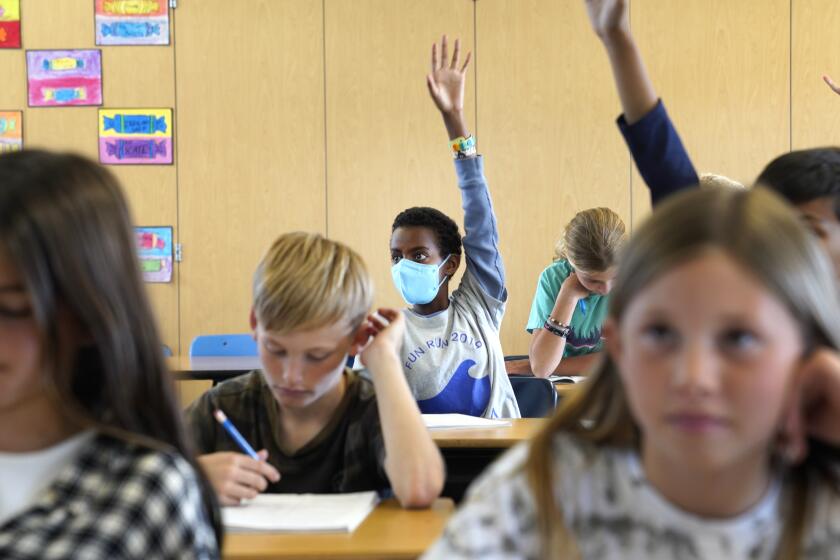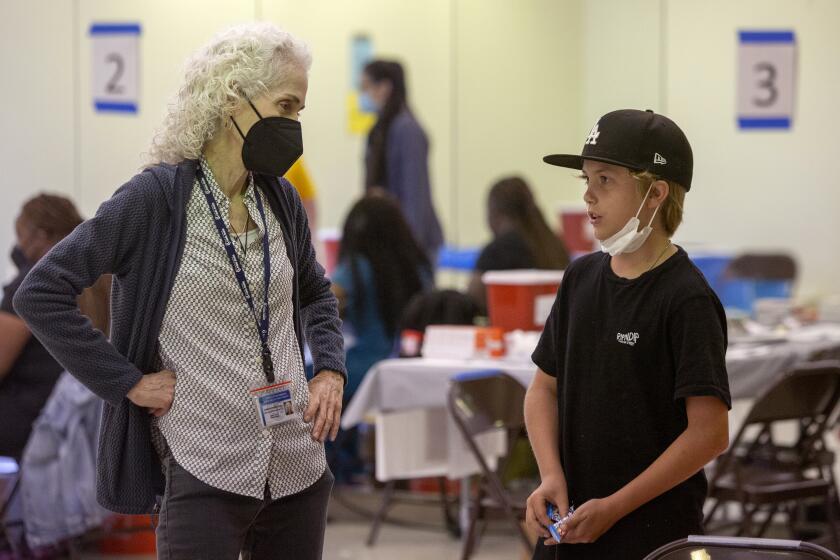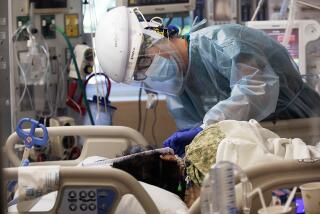Alameda County reinstates mask order as coronavirus cases soar

- Share via
Alameda County issued a new mask mandate in most indoor public settings, effective Friday, as coronavirus cases climb.
The county, home to Oakland, is the San Francisco Bay Area’s second-most populous. Alameda County’s move represents the first time a California county has issued a mask mandate since the winter Omicron surge faded.
The order does not apply to K-12 school settings through the end of the school year, nor does it apply to Berkeley, which is in Alameda County but has its own public health department. Berkeley’s K-12 public school system, however, has already implemented an indoor mask mandate.
Officials are deciding how best to respond now that COVID-19 cases are rapidly rising after plunging in the spring.
“Rising COVID cases in Alameda County are now leading to more people being hospitalized, and today’s action reflects the seriousness of the moment,” Dr. Nicholas Moss, Alameda County’s health officer, said in a statement.
“We cannot ignore the data, and we can’t predict when this wave may end. Putting our masks back on gives us the best opportunity to limit the impact of a prolonged wave on our communities.”
Alameda County has one of California’s highest coronavirus transmission rates, reporting about 354 cases a week for every 100,000 residents for the past week. That figure has climbed 20% from mid-May. A rate of 100 cases a week or more for every 100,000 residents is considered high.
By contrast, L.A. County’s rate is 299 cases a week for every 100,000 residents, according to data published Thursday.
The Alameda County mask order will require masks to be worn at indoor businesses and workplaces, including offices, stores, theaters and conference centers, as well as restaurants and bars when not eating or drinking; and on public transportation, including taxis and app-hailed rides, and at Oakland International Airport. Businesses and venue operators are required to post signage at all entrance points to communicate the mask requirement and “make reasonable efforts to ensure compliance in their setting,” the health order said.
Alameda County’s mask mandate has certain exceptions; the county won’t require masking in K-12 school settings through the few remaining days in the traditional school year, nor will the order apply to Berkeley, which has its own public health department. Masks need not be worn while working alone in a closed office or room; while swimming or showering at a gym; or while obtaining a medical or cosmetic service involving the head or face for which mask removal is needed to perform the service.
Alameda County is also allowing masks to be optional for performers at indoor live events, such as the theater, opera, symphony, religious choirs and professional sports; at religious gatherings when necessary to perform rituals; and at indoor gyms and yoga studios by people who are “actively engaged in periods of heavy exertion,” are swimming or diving, or when engaged in sports where masks create a risk to health, like wrestling and judo.
Masks will be required in other youth settings, including child care, summer school and youth programs. Children younger than 2 must not mask because of the risk of suffocation.
The concerns come as Alameda County, the Bay Area’s second-most populous county and home to Oakland, ordered a new mask mandate in most indoor spaces effective Friday.
The rate of new weekly hospitalizations jumped significantly in the last week. Alameda County is now reporting 9.3 new weekly coronavirus-positive hospitalizations for every 100,000 residents, up 26% from the previous week. That’s close to the threshold of 10 new weekly coronavirus-positive hospitalizations for every 100,000 residents, which would place Alameda County in a high COVID-19 community level as defined by the U.S. Centers for Disease Control and Prevention.
The CDC recommends that people in counties in the high COVID-19 community level practice universal masking in indoor public areas. A high COVID-19 community level is an indication of possible strain on the hospital system.
The CDC on Thursday placed 13 California counties in the high COVID-19 community level, affecting nearly 1 in 6 Californians. It’s the first time since mid-March that any county in the state was in that level.
The affected counties are Santa Clara, Sonoma, Solano, Marin and Napa in the San Francisco Bay Area; Sacramento, Placer, Yolo, El Dorado in the Sacramento Valley area; and Monterey, Mendocino, San Benito and Del Norte elsewhere in Northern California.
Alameda County’s rate of new weekly coronavirus-positive hospitalizations is 75% worse than L.A. County’s. L.A. County observed 5.3 new weekly coronavirus-positive hospitalizations for every 100,000 residents, an 18% increase from the previous week’s rate.
Sacramento and Placer counties have the highest weekly coronavirus-positive hospitalization rates in the state, 12.1; and other Bay Area counties also had high rates, with Sonoma and Marin counties reporting 11.8; Solano County, 11.5; Santa Clara and Monterey counties, 10.1; and San Francisco and San Mateo counties, 9.6.
Contra Costa and San Joaquin counties also had the same rate of new weekly coronavirus-positive hospitalizations as Alameda County.
The reinstatement of the mask order in Alameda County comes as coronavirus cases in Southern California also continue to climb and cause disruptions.
“If we continue on the current trajectory, we could find that cases and hospitalizations end up exerting stress on our healthcare system within just a few weeks,” Los Angeles County Public Health Director Barbara Ferrer said during a recent briefing.
More to Read
Sign up for Essential California
The most important California stories and recommendations in your inbox every morning.
You may occasionally receive promotional content from the Los Angeles Times.














